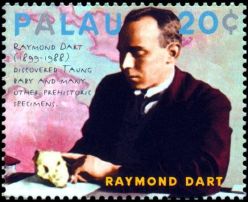
The Dart Procedures
The Dart Procedures website is intended primarily for Alexander Technique teachers, teacher-trainees, and students. The site is comprised largely of material generously provided by my teachers, Joan and Alexander Murray. This site is a work in progress, as more material will be added. –Marian Goldberg
The Dart Procedures Contents:
A Fascinating and Stimulating Exchange
A Fascinating and Stimulating Exchange: Raymond Dart's and Alex and Joan Murrays' Correspondence
A key part of the collaboration of Raymond Dart with Alex and Joan Murray was their written correspondence during the 1960s and 1970s.
The following is much of the written correspondence between Raymond Dart and Alexander and Joan Murray from 1967 to 1971. Most of the letters were handwritten and have been transcribed from xerox copies by Marian Goldberg. The typewritten letters are scans of xeroxes of of the originals. One hand printed letter from Alex Murray to Dart has been scanned from a xerox copy. This material has been generously provided by the Murrays.
1967 Dart/Murray Correspondence
1968 Dart/Murray Correspondence
1969 Dart/Murray Correspondence
1970s Dart/Murray Correspondence
Raymond Dart and Alexander and Joan Murray Correspondence 1971
21 March 1971
[Handwritten] Copy by Joan Murray for Alex Murray.
Dear Professor Dart,
Welcome back to America—we hope to an Eastern Spring. We had a taste of a Mich. one a week or so ago but all it seems to have done is liberate the hibernating flu germs and we have all succumbed in the last few days. Fiona seems over hers but I & Joan are still snivelling & coughing.
A few weeks ago the powers that be in the dept. of Arts & Letters awarded me an assignment to research for the the summer—I will received $2600 in order to free me from the necessity of working during June - Sep to enable me to devote my full attention to making a selection of your papers. You may remember that I applied last year and was short listed but unsuccessful. I have been working since Xmas re? reading the papers I already have (some 40 odd) and collecting new ones. I had hoped to send you a brief survey with this letter but as I took ill last week and had left all your works and your papers at school I can only give you a brief ______ for your comment.
As Maisel suggested a generally understandable collection I thought that “The Significance of Skill” might make a good theme. I would propose a brief introduction to explain how I cam to embark on such a project, followed by the “Do it yourself procedures” (illustrated). I have sent the enclosed sketches to a friend in London (a pupil of Walter’s) whom I think will do an excellent job—if she has time—I will know shortly. Then a selection of various articles—completed or edited as you think appropriate (I would suggest a compressed version of your four contributions to Alexander and a biographical sketch (Tobias-Leech if possible).
If it is feasible, I would like to publish the Do-it-yourself article separately first of all in the IAHP Journal—if you could write a brief text to accompany the illustration—well and good. If you do not have the time I would assemble one from your articles—I suggest 1) the illustrations with instructions. 2) Phylogenetic survey. 3) Comparison with D–D and conclusions. I have added a headstand starting with foetal crouch as example of turning ones horizontal exploration through 90 degrees. I have found it very helpful in freeing my upper thoracic spine, which as you may recall, was rather fixed.
Due to my own stupidity, I failed in the past to locate Elliot Smith’s works in the library. I intended to borrow his “Essays on Human Evolution” through inter library loan & checked our catalogues again to find that we have half-a-dozen of his books. I have read his “Diffusion of Culture,” “Essays in Evolution,” “Evolution of the Mind” in Campion's "Neural Basis of Mind" [Thought], “Migration of Early Culture,” “Human History,” & ”Shell Shock.” When I first read the Campion Essay (& introduction) there was so much in it that was familiar to me from your having written it or said it that I began to envisage an introduction in incorporating [?] “Three Great Australians: GES, FMA and RAD but the more I read the more frightened I became at the prospect & when I read Warren R. Dawson Biographical Collection of Essays and saw that GES bibliography was twice the length of your own, I flinched & decided that in order to achieve anything at all, I must start with what I really know. Thus, I have drawn up a rough draft of an introduction explaining how much help I gained from reading Malocclusion, doing your procedures & then meeting you. How I hoped to understand more of the message of your Alex. papers by reading your earlier anatomical ones. How I have read them in the spirit in which I learnt foreign languages–—reading widely with whatever understanding I have at the time. The vocabulary increases insensibly with constant repetition without the use of dictionaries. This is in fact how I have come to grasp what little I understand of anatomical writings. I will say in a few words what I understand from each paper—how it was relevant to me as a performer & teacher and perhaps quote a few paragraphs from each article (“Skill & Emotion” from the the neopallium for example). Your more general papers are of obvious interest to thinking people & require little if any introduction. Your obituaries of B______ ______ & even Anderson Stuart [?], also your review of Andrew Smith tie up with the Diffusion of Scots—of which I am a part, also your reference to [?] .U. in Science and Science Writers makes me hope that I can show you to what extent you have managed to convey meaning in the study of the Dogfish brain [?] to a Scottish musician. The aero-aquatic origins of speech & music are other points of contact. On this score, I have in my possession a pottery ocarina—pre-Columbian Mexican 1200 years old which plays the same tune as _______ noted from a Lulu pipe (utilising the closed & open harmonic series). The pentatonic scale is identical with that utilised by Debussy in an unaccompanied flute solo “Syrinx.”
But I digress---I would be very grateful for the opportunity to see you again in the relatively near future. If it were possible I would like to visit the Institutes at a week-end, read those papers in the archives which I don’t possess, discuss everything with you in whatever time you can spare me, & spend part of Mon. reacquainting myself with Institutes work. Perhaps sometime towards the end of April would be possible. I can come anytime that suits you, but I would hope to have sketches, etc. prepared by then. I enclose slides of the poster I mentioned to you when we last met. Dr. Niblock has the original—I will bring 2 black and white copies for you when I come to the Institutes. Dr Niblock took the pictures himself.
[From Alex Murray]
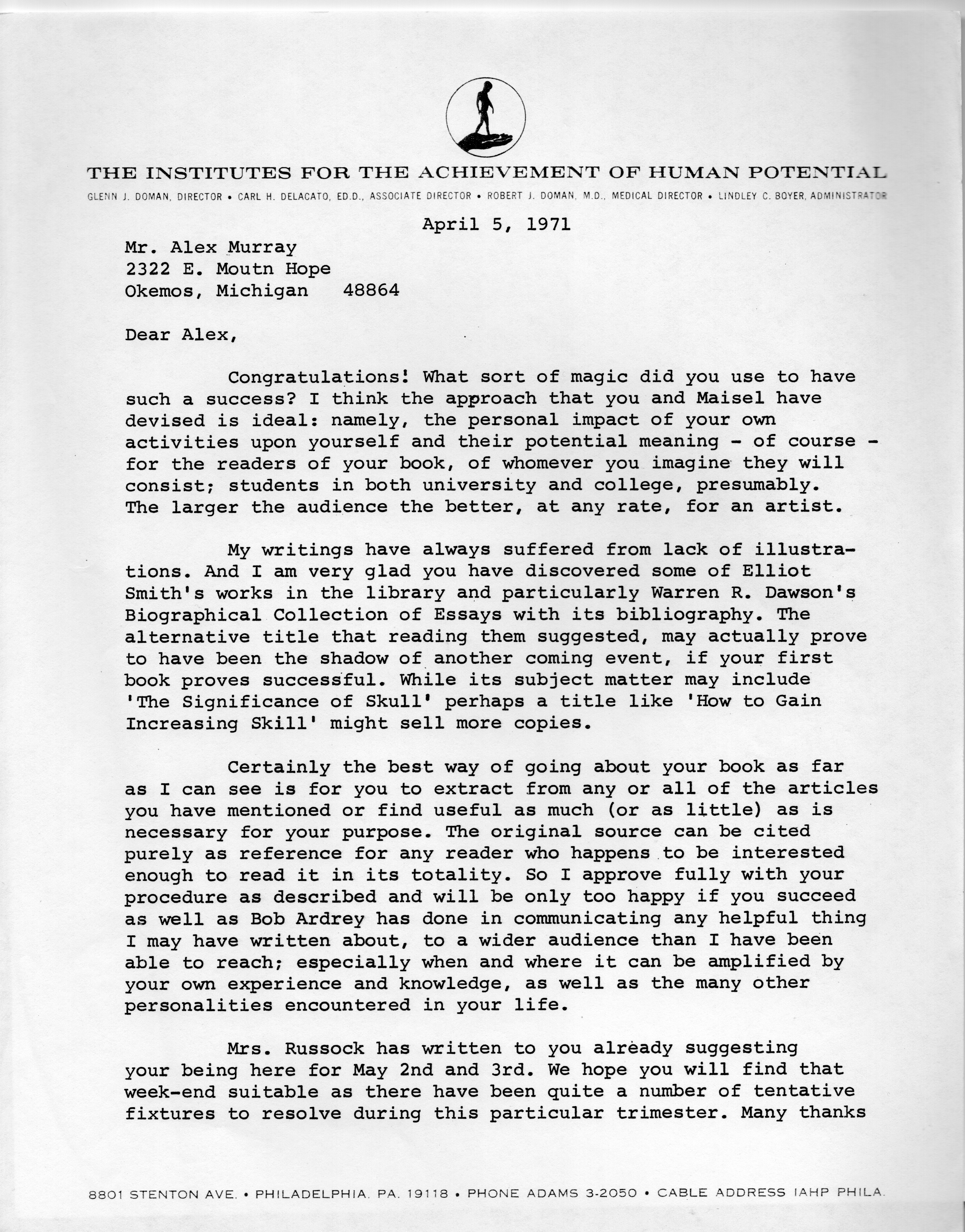
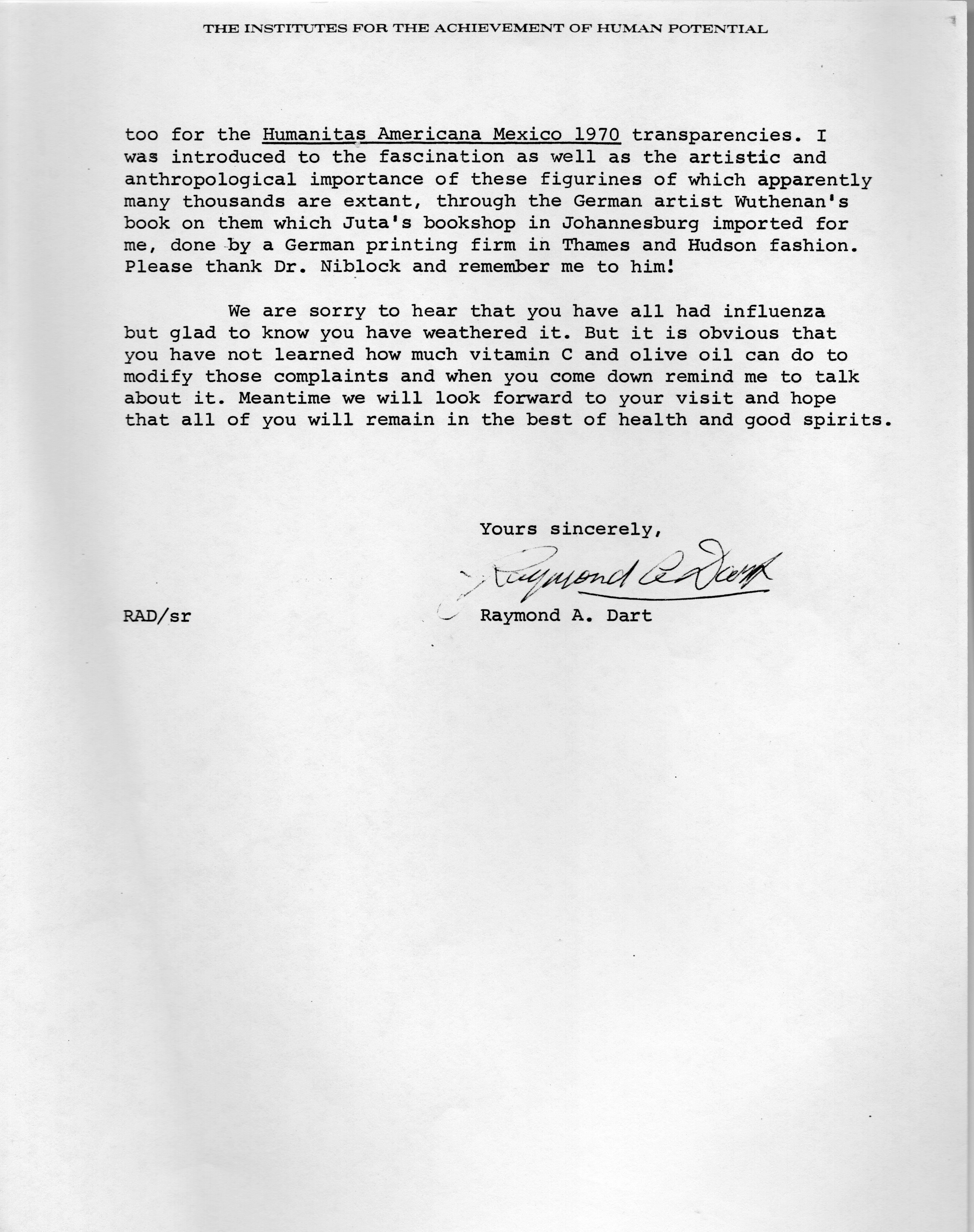
May 12, 1971
Institutes for the Achievement of Human Potential
Dear Alex,
It is most kind of you to have sent me these two Elliot Smith books for the happily-arranged extended use. I am very grateful & they will be. most helpful in resuscitating old memories & certainly useful in assisting with the preparation of my brief tribute to his memory!
Thanks too for the two copies of the article from the Journal of Homeopathy which one was given to Dr. Evan Thomas & which we are sure he enjoyed even if he did not find himself in full accord with the inferences drawn but the by the author (from the facts he had assembled. As for Mrs. Russock, she is so conscious of your appreciation of her kindnesses that passing on your message is the carrying further[?] coal to Newcastle.
She particularly enjoyed seeing the copies of the Mexican Figurines Poster & also looking at the colour reproductions you had photographed. She even has designs which may or may not prove viable & inveighing an artist to touch one of them up according to the colours detected in your transparencies. But if she is successful that lies somewhere in the future.
The newest cause of delay in publication according to Carl Delacato, & I feel sure my wife would agree is the time taken in by authors obtaining written permission from the publishers of the books & editorial staffs of the journals in which the writings that
will be utilised have appeared. It’s best to send a formal letter for him to sign.
In the case of publications by the Thomas Firm with which he is intimately associated, the securing of these permissions is the responsibility of the author as I believe Lee[?] explained to you. He also said he would send you a contract that you could use & which would be helpful to you in many ways. I hope you will have taken action in these matters already & if not, that you will write to him straight away about any matter that needs attention from the outset of your programme.
Meanwhile with every good wish for your success & kindest regards to all three of you in which I’m sure Marjorie would be joining _________,
Yours sincerely
Raymond A Dart
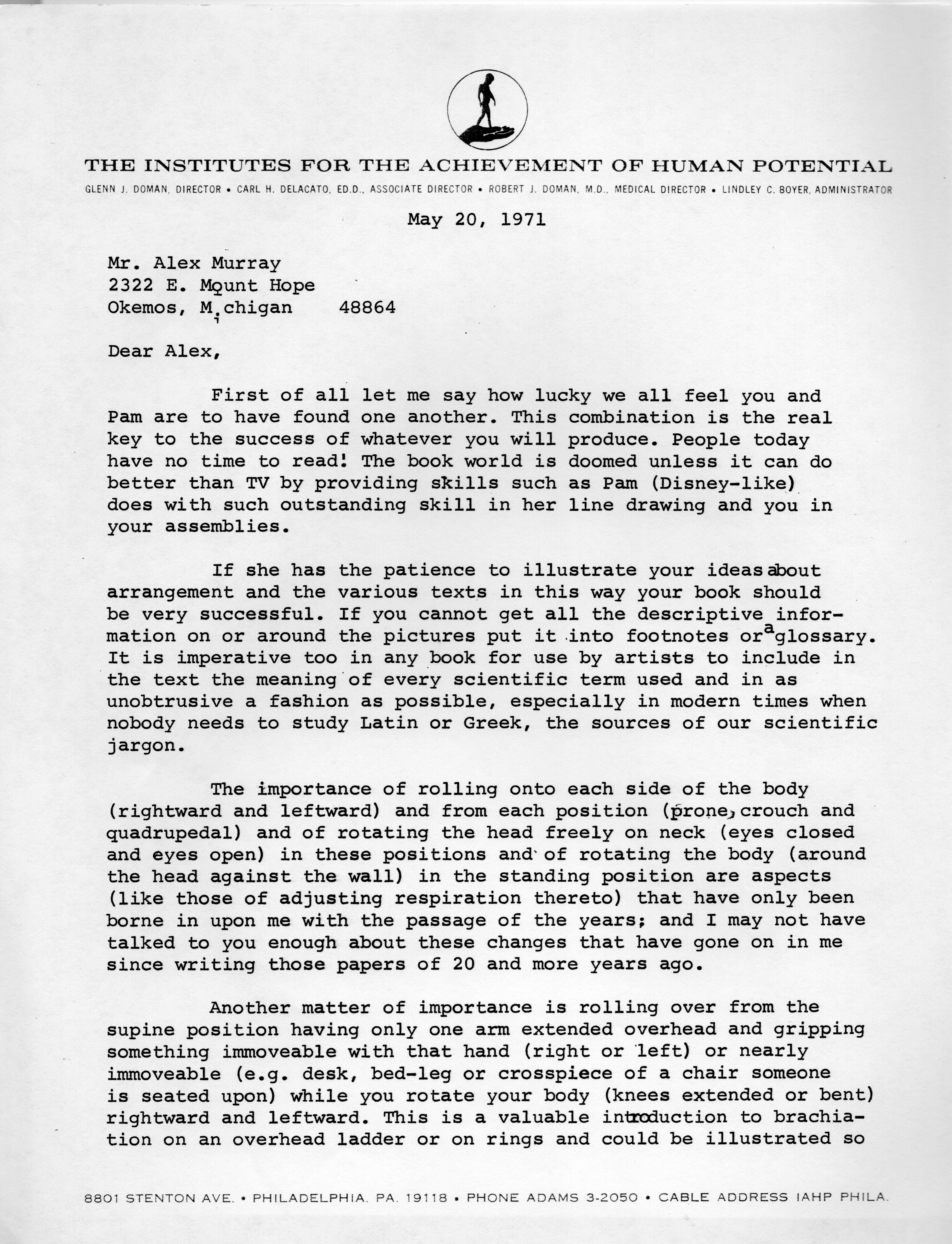
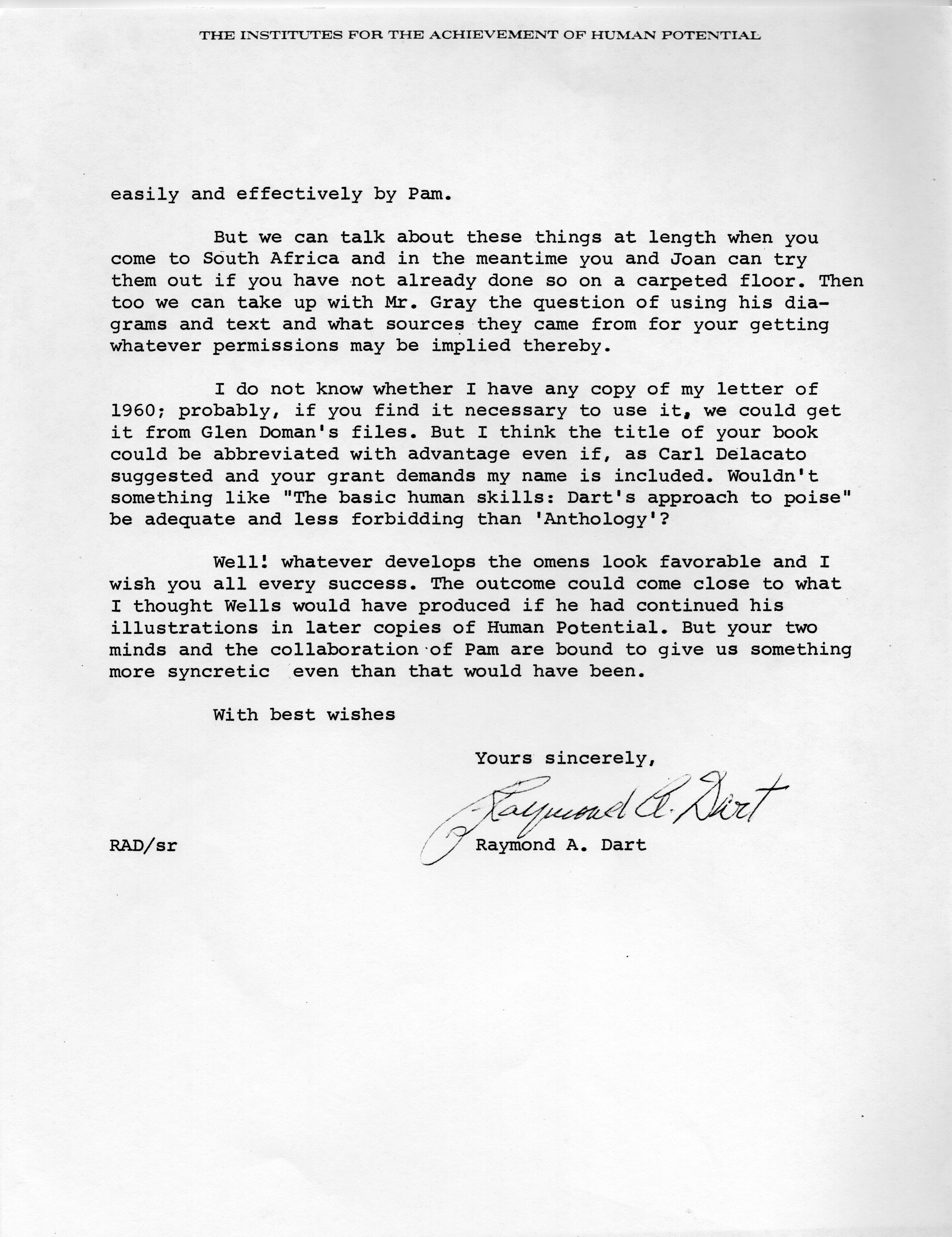
The Institutes for the Achievement of Human Potential
June 10, 1971
Dear Alex,
Dispatched today were the books by Elliot Smith Human History and Essays on the Evolution of Man, which you were so kind to send from the library of Michigan State University. They were of tremendous help to me. Many, many thanks for their use. They have been directed to your home. It has enabled me to send off a preliminary draft to Australia, to which I hope to get back their reactions while I can be considering any emendations that may be desirable.Yours sincerely,
Raymond A. Dart
P.S. Re the proposed book title your general idea is excellent but I think too long & the word “business” could have unpleasant connotations for some people. I have made out a list of alternative titles which you & Joan can let simmer along with any others that
turn up & we can decide in Johannesburg.
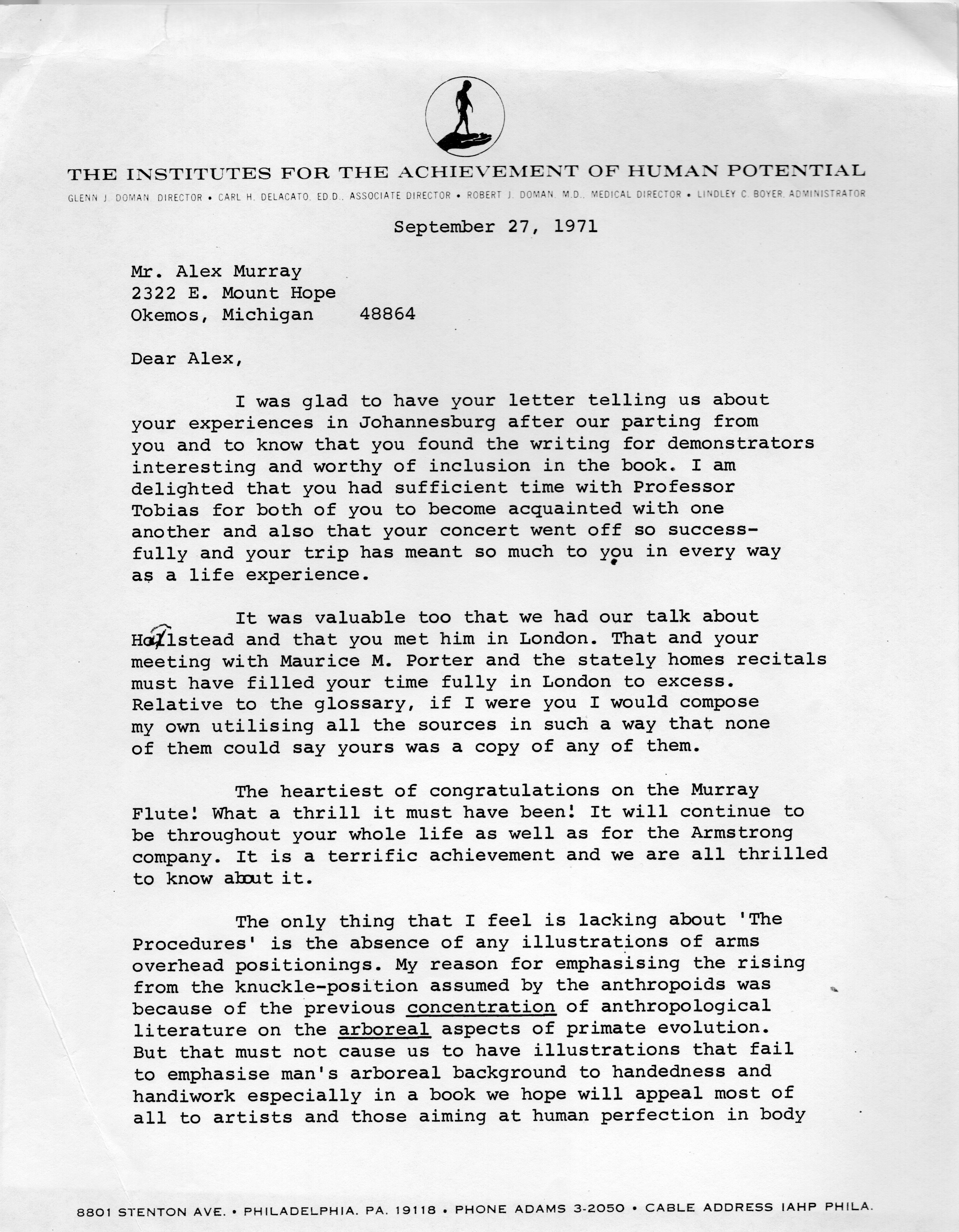
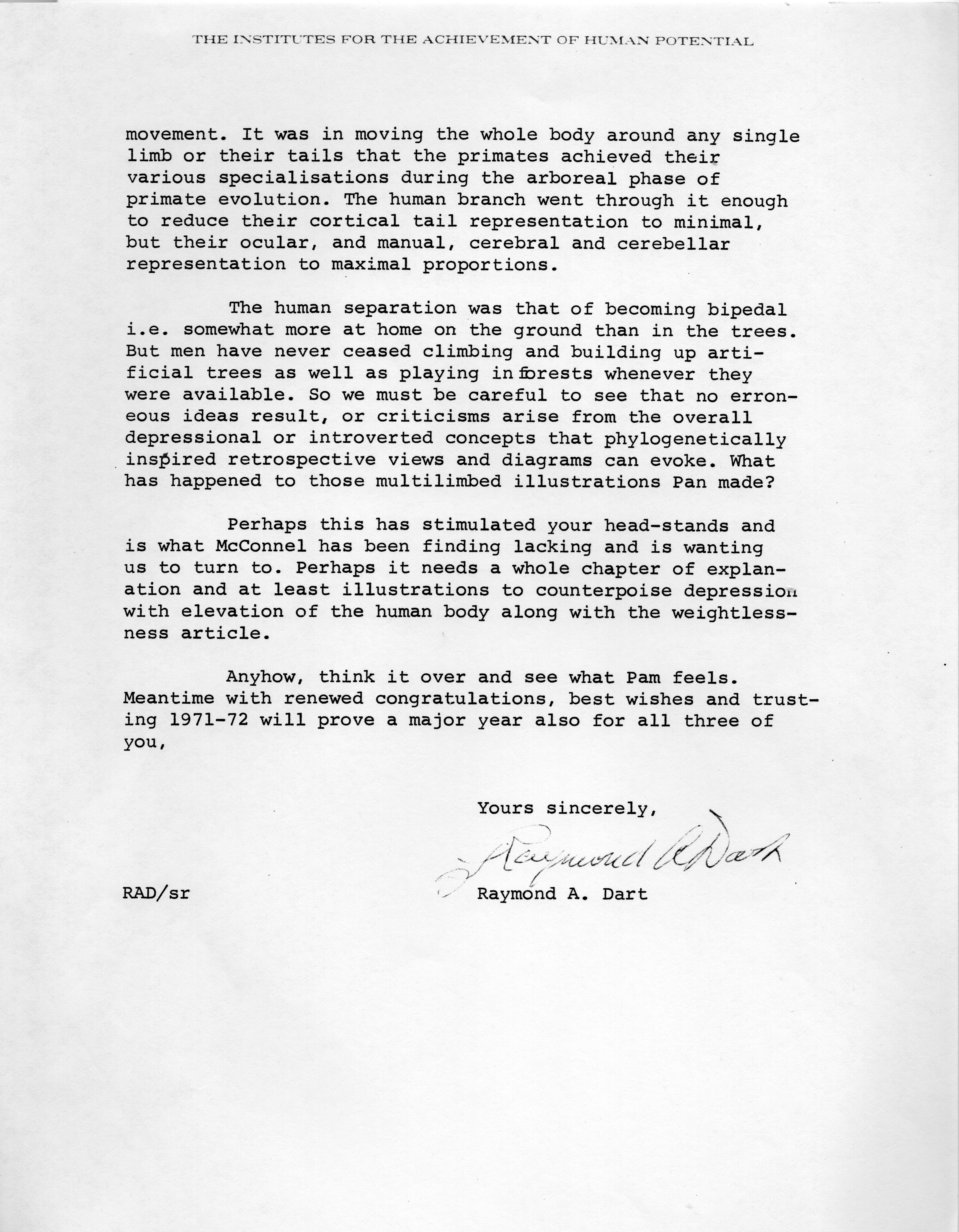
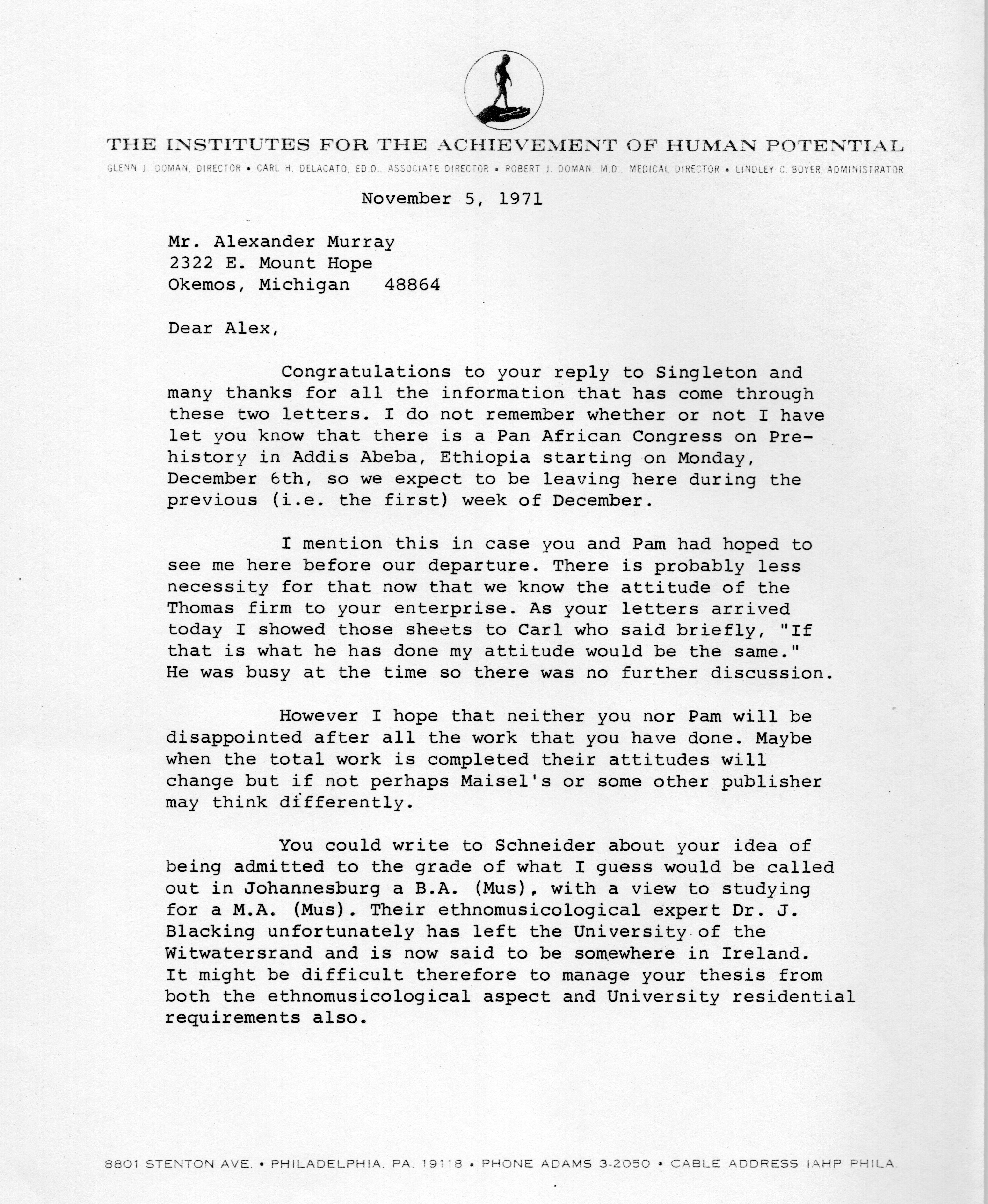
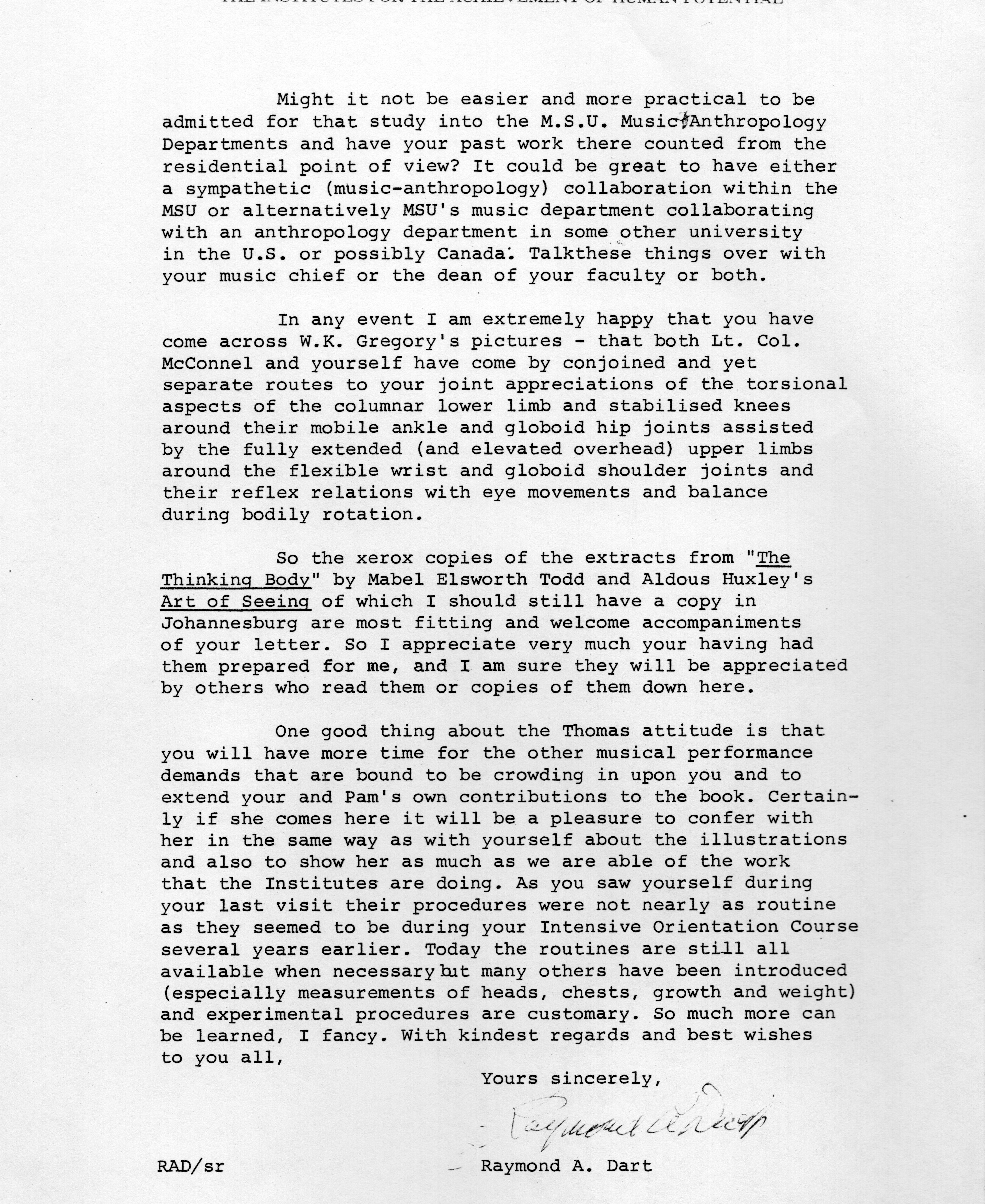
1967 Dart/Murray Correspondence
1968 Dart/Murray Correspondence
1969 Dart/Murray Correspondence
Return to:
Alexander Technique: The Insiders' Guide
Alexander Technique: The Insiders' Guide and The Dart Procedures websites created and maintained by Marian Goldberg, Alexander Technique Center of Washington.
“It was in moving the whole body around any single limb or their tails that the primates achieved their various specialisations during the arboreal phase of primate evolution” –Raymond A. Dart. Letter to Alex Murray.
September 27, 1971
